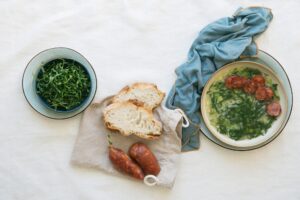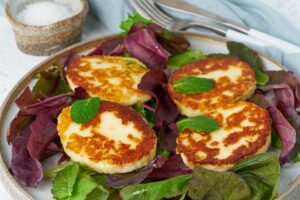Portuguese vs Cypriot Cuisine | Mediterranean Food Guide
Two Mediterranean Culinary Traditions
Portuguese and Cypriot cuisines both emerge from Mediterranean culinary traditions, but their distinct geographic positions create fascinating differences in ingredients, cooking methods, and flavor profiles. Portugal’s Atlantic coastline shapes a cuisine rich in seafood and influenced by centuries of maritime exploration, while Cyprus’s position at the crossroads of Europe, Asia, and Africa creates a unique fusion of Greek, Turkish, and Middle Eastern flavors.
Both food cultures share Mediterranean values – fresh ingredients, seasonal cooking, family-centered meals, and the social importance of food. However, Portugal’s colonial history brought spices and techniques from Brazil, Africa, and Asia, while Cyprus’s strategic location created influences from Ottoman, Byzantine, and Levantine culinary traditions.

Understanding these culinary differences helps Cypriots appreciate Portuguese food culture and provides Portuguese visitors insight into Cyprus’s unique Mediterranean cuisine that differs from both Greek and Turkish traditions.
Historical Influences and Culinary Development
Portuguese Culinary Evolution
Maritime Heritage: Portugal’s Age of Exploration (15th-16th centuries) profoundly shaped national cuisine. Portuguese explorers brought back spices, techniques, and ingredients from Brazil, India, Africa, and the Far East, creating a globally influenced Mediterranean cuisine.

Colonial Exchanges: Portuguese colonies contributed key ingredients still central to modern Portuguese cooking:
- Brazil: Tomatoes, potatoes, peppers, beans
- India: Curry spices, cinnamon, black pepper
- Africa: Piri-piri peppers, cooking techniques, preserved fish methods
- Asia: Tea culture, rice dishes, soy-based seasonings
Atlantic Focus: Portugal’s Atlantic position made seafood central to the cuisine from prehistoric times. The Portuguese developed sophisticated fish preservation, preparation, and cooking methods that define national culinary identity.

Regional Diversification: Portugal’s varied geography – from northern mountains to southern plains to Atlantic islands – created distinct regional cuisines while maintaining national characteristics.

Cypriot Culinary Heritage
Crossroads Position: Cyprus’s location between three continents made it a meeting point for culinary traditions. The island absorbed influences from:

- Greek: Orthodox Christian food traditions, Mediterranean ingredients
- Turkish: Ottoman cooking methods, spice usage, pastry techniques
- Arab: Middle Eastern flavors, preservation methods, sweet preparations
- Italian: Pasta influences, cheese-making, bread traditions
Agricultural Foundation: Cyprus’s Mediterranean climate and fertile soil created agriculture-based cuisine emphasizing:

- Grains: Wheat, barley, legumes as dietary foundations
- Olives: Olive oil as primary cooking fat and flavor base
- Vegetables: Seasonal vegetables, preservation techniques, wild greens
- Livestock: Goat, sheep, pig providing meat, dairy, and cooking fats
Religious Influences: Orthodox Christian traditions shaped Cypriot food culture through:
- Fasting periods: Extensive vegetarian and vegan cooking traditions
- Feast celebrations: Elaborate holiday foods and sweets
- Monastic traditions: Simple, ingredient-focused cooking methods
Staple Ingredients and Cooking Foundations
Portuguese Culinary Staples
Seafood Centrality: Portuguese cuisine revolves around seafood in ways Cyprus cuisine does not:
- Bacalhau (salt cod): National ingredient with 365 claimed preparation methods
- Sardines: Fresh and preserved, essential to Portuguese identity
- Octopus: Prepared in dozens of traditional ways
- Shellfish: Clams, mussels, prawns in regional specialties
Atlantic Fish Varieties: Portugal’s Atlantic access provides fish unavailable in Mediterranean:
- Sea bass, sea bream, horse mackerel, tuna
- Deep-sea species: Monkfish, turbot, sole
- Preserved fish: Complex traditions of salting, drying, smoking
Pork Dominance: Unlike Cyprus’s mixed meat traditions, Portuguese cuisine emphasizes pork:
- Chouriço: Spiced sausages central to many dishes
- Presunto: Cured ham traditions
- Leitão: Roast suckling pig as celebration food
Rice Cultivation: Portugal grows rice domestically, making it more central to cuisine than in Cyprus:
- Arroz dishes: Rice as main course, not just side dish
- Risotto-style: Creamy rice preparations with seafood, meat
Cypriot Ingredient Foundations
Mediterranean Trinity: Cyprus cuisine builds on classic Mediterranean base:
- Olive oil: Primary cooking fat and flavor foundation
- Wheat: Bread, pasta, bulgur as dietary staples
- Wine: Both for drinking and cooking enhancement
Mixed Meat Traditions: Cyprus uses broader range of meats than Portugal:
- Lamb: Most prized meat, especially for celebrations
- Goat: Traditional meat with unique flavor profiles
- Pork: Important but not dominant like in Portugal
- Chicken: Everyday meat with various preparations
Dairy Emphasis: Cyprus dairy traditions exceed Portuguese:
- Halloumi: Unique Cypriot cheese with no Portuguese equivalent
- Anari: Fresh cheese used in sweet and savory dishes
- Yogurt: Central to cooking and eating traditions
Wild Foods: Cyprus maintains stronger traditions of wild food gathering:
- Wild greens (horta): Seasonal wild vegetables unknown in Portugal
- Capers: Wild capers flavoring many dishes
- Wild herbs: Oregano, thyme, sage gathered seasonally
Signature Dishes and National Specialties
Portuguese National Dishes
Bacalhau à Brás: Shredded salt cod with thin-cut fried potatoes and scrambled eggs, representing Portuguese comfort food. The dish combines the national fish (bacalhau) with potatoes (New World ingredient) in simple, satisfying preparation.
Francesinha: Porto’s famous sandwich with multiple meats, cheese, and beer-based sauce, showing Portuguese hearty eating traditions and regional specialization.
Caldo Verde: Kale and potato soup with chouriço, representing northern Portuguese peasant cooking that became national comfort food. Simple ingredients transformed into satisfying, nutritious meal.
Pastéis de Nata: Custard tarts that are Portugal’s most famous sweet export, representing Portuguese pastry expertise and conventual sweet traditions.
Cataplana de Marisco: Seafood stew cooked in special copper pan, showcasing Portuguese seafood mastery and regional Algarve cooking traditions.
Cypriot Signature Dishes
Souvlaki: Grilled meat skewers that represent Cyprus’s outdoor cooking traditions and social eating culture. Different from Greek souvlaki in preparation and serving methods.
Kleftiko: Slow-cooked lamb wrapped in parchment, representing Cyprus’s pastoral traditions and sophisticated slow-cooking techniques developed over centuries.
Afelia: Pork cooked with wine and coriander seeds, showing Cyprus’s unique spice usage and wine-cooking traditions that differ from neighboring countries.
Kolokotes: Pumpkin pastries representing Cyprus’s sophisticated pastry traditions and vegetarian cooking during Orthodox fasting periods.
Moussaka: Layered eggplant and meat dish that’s uniquely Cypriot, different from Greek versions in spicing and preparation methods.
Cooking Methods and Techniques
Portuguese Cooking Approaches
Grilling and Charcoal: Portuguese excel at charcoal grilling, especially for:
- Sardines: Grilled over charcoal with coarse salt
- Chicken: Piri-piri chicken with spicy marinade
- Seafood: Various fish grilled with minimal seasoning
Slow Braising: Portuguese develop complex flavors through slow cooking:
- Wine-based braises: Using Portuguese wines as cooking liquid
- Tomato-based stews: Influenced by New World ingredients
- Olive oil poaching: Gentle cooking in olive oil
Rice Cooking: Portuguese rice dishes use techniques different from Cyprus:
- Absorptive method: Rice absorbs all cooking liquid
- Seafood integration: Cooking rice with seafood broths
- Creamy textures: Achieving risotto-like consistency
Cypriot Cooking Traditions
Clay Pot Cooking: Cyprus maintains strong traditions of clay pot cooking:
- Arni psito: Lamb cooked in clay ovens
- Stews and casseroles: Slow-cooked in traditional pottery
- Bread baking: Village ovens for communal bread making
Preservation Techniques: Cyprus developed sophisticated food preservation:
- Pastourma: Cured meat traditions
- Cheese aging: Halloumi and other cheese preservation
- Vegetable pickling: Preserving seasonal abundance
Mezze Preparation: Cyprus mezze culture requires specific techniques:
- Multiple small dishes: Balancing flavors and textures
- Hot and cold combinations: Temperature contrasts
- Progressive serving: Timing different mezze courses
Spice Usage and Flavor Profiles
Portuguese Spice Traditions
Colonial Spice Integration: Portuguese cuisine incorporates spices from former colonies:
- Piri-piri: African chili peppers, now Portuguese staple
- Cinnamon: Used in both sweet and savory dishes
- Black pepper: Heavily used due to Indian trade connections
- Paprika: Spanish influence in border regions
Herb Preferences: Portuguese favor specific herbs:
- Coriander (cilantro): Fresh and seed form, very common
- Bay leaves: Essential in many traditional dishes
- Parsley: Flat-leaf variety predominant
- Oregano: Less emphasized than in Cyprus cuisine
Salt and Acid Balance: Portuguese cooking balances salt and acid through:
- Wine vinegar: Pickling and flavor enhancement
- Lemon: Less central than in Cyprus cooking
- Wine: Both red and white for acid and depth
Cypriot Flavor Characteristics
Eastern Mediterranean Spicing: Cyprus uses spice combinations reflecting eastern influences:
- Coriander seeds: Ground spice, not fresh herb emphasis
- Cumin: Middle Eastern influence in meat dishes
- Cinnamon: Both sweet and savory applications
- Mint: Fresh and dried, more prominent than in Portugal
Herb Abundance: Cyprus cuisine emphasizes fresh herbs:
- Oregano: Wild oregano with intense flavor
- Thyme: Wild varieties with unique taste profiles
- Parsley: Both flat and curly varieties
- Dill: Common in cheese and vegetable dishes
Citrus Integration: Cyprus cooking uses citrus differently than Portugal:
- Lemon: Dominant acid, used extensively
- Orange: Both sweet and bitter varieties in cooking
- Bergamot: Unique Cyprus citrus in traditional sweets
Wine and Beverage Pairings
Portuguese Wine Culture
Extensive Wine Production: Portugal produces wines unavailable elsewhere:
- Vinho Verde: Light, slightly sparkling wines
- Douro table wines: Full-bodied reds from Port region
- Dão wines: Elegant mountain wines
- Regional varieties: Hundreds of indigenous grape varieties
Food and Wine Integration: Portuguese systematically pair wines with foods:
- Seafood wines: Light whites with grilled fish
- Meat wines: Full reds with game and roasted meats
- Regional matching: Local wines with local foods
Port Wine Tradition: Fortified wine culture unique to Portugal:
- Aperitif ports: White and tawny varieties
- Dessert ports: Vintage and aged varieties
- Cooking integration: Port in sauces and reductions
Cypriot Beverage Traditions
Commandaria Legacy: Cyprus produces world’s oldest named wine:
- Sweet wine tradition: Ancient dessert wine methods
- Religious connection: Monastic wine-making traditions
- International recognition: Historic wine with modern production
Local Wine Renaissance: Modern Cyprus wine industry development:
- Indigenous varieties: Xynisteri, Maratheftiko grapes
- Mountain viticulture: High-altitude wine production
- International styles: Modern wine-making techniques
Traditional Drinks: Cyprus maintains unique beverage traditions:
- Zivania: Traditional grape spirit, similar to grappa
- Cyprus coffee: Preparation and serving rituals
- Herbal teas: Wild herb infusions and traditional remedies
Meal Structure and Eating Patterns
Portuguese Meal Traditions
Meal Timing: Portuguese eat later than many Europeans:
- Lunch: 1:00-2:30 PM, substantial main meal
- Dinner: 8:00-10:00 PM, can be lighter than lunch
- Late socializing: Post-dinner coffee and conversation
Course Structure: Portuguese meals follow structured patterns:
- Appetizers: Simple starters, often soup
- Main course: Fish or meat with sides
- Dessert: Traditional sweets or fruit
- Coffee: Essential meal conclusion
Social Aspects: Portuguese dining emphasizes social connection:
- Family meals: Multi-generational dining common
- Restaurant culture: Leisurely meals with conversation
- Festival foods: Special foods for celebrations
Cypriot Eating Culture
Mezze Tradition: Cyprus mezze culture creates unique meal experiences:
- Progressive dining: Many small dishes over long period
- Sharing emphasis: Communal plates and social eating
- Variety: 20-30 different dishes in full mezze
- Pacing: Slow, social consumption over hours
Seasonal Eating: Cyprus maintains strong seasonal eating patterns:
- Summer focus: Cold dishes, grilled foods, fresh vegetables
- Winter emphasis: Hearty stews, preserved foods, warming dishes
- Religious fasting: Orthodox calendar affects eating patterns
Hospitality Expression: Cypriot food culture expresses hospitality:
- Guest feeding: Elaborate food offerings to visitors
- Abundance showing: Serving more food than can be consumed
- Insistence: Cultural pressure to eat offered food
Both Portuguese and Cypriot cuisines offer rich culinary traditions that reflect their unique geographic positions, historical influences, and cultural values. While both share Mediterranean foundations, their distinct approaches to ingredients, cooking methods, and dining culture create fascinating contrasts and learning opportunities.
Understanding these culinary differences enhances appreciation for both traditions while revealing how geography, history, and culture shape the foods we eat and the ways we share meals with family and friends.
Read More:
Sources:
